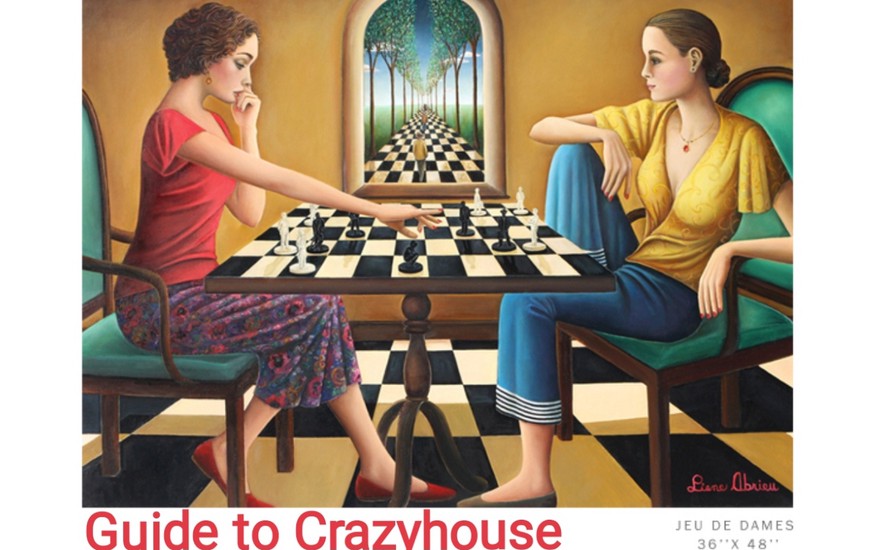
Liane Abrieu, Jeu de Dames
Guide to Crazyhouse
So you know the rules of crazyhouse, but how to get better?Crazyhouse is fast-paced, so it needs strong tactics as well as good awareness of positional weaknesses. The number of possible moves in any given position is much greater than in standard chess, but the number of these moves which are actually good is much narrower because both sides are a certain number of tempi away from getting mated and doing nothing is not an option. If your attack is faster, then you can often ignore your opponent's threats and attack! If your attack is slower, then you better defend!
Unlike regular chess, draws are rare because pieces keep being reintroduced to the board. Check out Crosky’s crazyhouse overview. Here are some further tips to improve:
• As GM Yasser Seirawan would say, first and foremost is king safety. This does not necessarily imply castling – you can also drop pieces around your king to guard it from serious threats.
• Develop your pieces in the opening and control key squares, especially around your king.
• Beware of holes in your position. A hole can be an opening for an opponent piece which can then support another and another. If pieces do enter, chase them away. As helmsknight would say, “get out of my house!”.
• Beware of piece sacs, for example on f2/f7 or g2/g7, especially if the opponent has pieces to follow up the attack.
• Crazyhouse is a very attacking game and almost every move should have either attacking or defensive purpose. Sometimes the best defence is counter-attack! If you are worried about drops on h3, maybe drop at h6. You can sometimes defend by creating an attack which is faster and cannot be ignored.
• Initiative is more important than material. If a player has initiative they can drop their pieces in hand with check or with threats and dominate the board. It’s important to cash in on this dominance because if the initiative runs out, the opponent can take back the initiative with their pocket full of pieces in hand to take back control.
• One way in which even intermediate players often lose initiative is they move their queen to a square where it can be attacked with tempo. It is often better to exchange the queen for a piece and positional compensation rather than let it get chased around the board losing tempi. The way to avoid this is to try to ensure that an open queen is always attacking something that cannot be defended with a counter-attack, and in certain instances (best illustrated in the games of JannLee) to be willing to sacrifice it!
• As for material, because pawns can drop anywhere on the board including the seventh rank, they are more valuable than in regular chess, so minor pieces including rooks are worth about 2 pawns. Because the queen can be hit with tempo by minors, it is worth less, so a queen is worth about 2 minors. So a simplistic assignment of piece values would be: 1 for pawns, 2 for minors, 4 for queens.
• Knights are wonderful attackers because their threats can’t be blocked and bishops are good defenders.
• Bishops control channels of a single colour so they can combine defence with attack. For example Ba5+ can cover c7, or Bxa8 continues to defend g2.
• Pawns and bishops are known as diagonals because they penetrate an opponent position along diagonals of a single colour. If all your pawns are on light squares, you must take care to defend dark square weaknesses, perhaps with bishops on dark squares and knights on light squares. For more on the importance of colour complexes, check out mastertan’s visual guide to colour complexes by mastertan.
• Unlike chess, doubled pawns are less of a weakness because pawn structures can be fixed with pawns in hand, and can even be a strength because a doubled pawn controls squares of both colours.
• Crazyhouse is still chess, so common chess tactics still apply:
— not hanging mate in 1,
— not hanging pieces,
— not blocking in your own pieces,
— trapping opponent pieces,
— discovered checks,
— forks, and
— pins.
Because pieces can land anywhere on the board, one must be even more alert. For example a queen on g3 might fall to N@e2+ if the king is on g1!
• Become familiar with common mating patterns. For example:
— smothered mate: N@h6+ Kh8 R@g8+ RxR Nxf7#.
— back-rank mate: study 1 2 | blog
— magnet mate: drawing the king to a checking square
— cookie-crumb mate: study
— moon mate: study
For more examples of mating patterns and for advanced puzzle training, check out the following:
— beginner puzzle study,
— detailed index of practice studies on lichess,
— crazyhouse theme tags at Chess Variants Puzzle Trainer,
— introduction to crazyhouse 960 themes,
— playlist of instructive crazyhouse videos.
The first video in this playlist is especially popular. Much more important than learning opening lines is understanding how to exploit and defend weaknesses in any opening: study.
https://www.youtube.com/watch?v=ILA8Cw19D0A
I hope you find these resources helpful! We hope to continue to add to them and to the crazyhouse blog.
—okei (with contributions from MMichael & theLazyMD)

